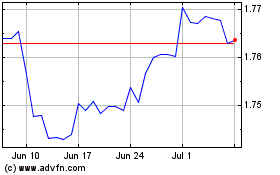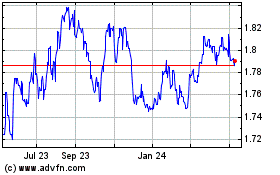Euro Weakens As German Industrial Output Falls Unexpectedly
October 07 2015 - 12:11AM
RTTF2
The euro slipped against its major rivals in early European
trading on Wednesday, as Germany's industrial production declined
unexpectedly in August and traders await the minutes of the
European Central Bank's September meeting for further insight
regarding the expansion of quantitative easing programme.
Data from Destatis showed that industrial production declined
1.2 percent in August from the prior month, offsetting the 1.2
percent rise in July. Economists had forecast the growth rate to
ease to 0.2 percent. July's growth was revised up from 0.7
percent.
The data added to evidence that slowing growth in China and
weakness in other developing markets are hurting German
industry.
The European Central Bank releases account of the monetary
policy meeting in September on Thursday. Investors seek more clues
about any discussion of additional stimulus in the minutes, given
slowing global growth and low inflation.
In its latest World Economic Outlook released on Tuesday, the
International Monetary Fund lowered the global growth forecast for
this year to 3.1 percent from 3.3 percent, saying global growth
remains 'moderate and uneven' amid the modest pick-up in advanced
economies and the slowdown in emerging market.
Euro area growth forecast for this year was retained at 1.5
percent, while the outlook for next year was cut to 1.6 percent
from 1.5 percent.
Market participants cautiously await the start of earnings
season, with aluminum giant Alcoa due to announce its third-quarter
results on Thursday.
The currency was modestly lower in the previous session.
In early European deals, the euro slipped to a 6-day low of
1.0878 against the Swiss franc, compared to 1.0895 hit late New
York Tuesday. The next possible support for the euro-franc pair may
be located around the 1.075 level.
The euro was trading lower at 0.7381 against the pound, 1.1257
against the greenback and 135.11 against the yen, off its early
high of 0.7404, 2-day highs of 1.1284 and 135.63, respectively. If
the euro extends decline, it is likely to find support around 1.11
against the greenback, 0.725 against the pound and 134.00 against
the yen.
The euro reached as low as 1.4608 against the loonie, from its
early high of 1.4710. Continuation of the euro's downtrend may
drive the euro down to a support around the 1.45 area.
The 19-nation currency weakened to 1.6968 against the kiwi, its
lowest since August 21, while touching nearly a 6-week low of
1.5597 against the aussie. On the downside, the euro may locate
support around 1.68 against the kiwi and 1.54 against the
aussie.
Looking ahead, U.K. industrial and manufacturing output for
August will be published in the European session.
Canada building permits for August, Energy Information
Administration's weekly crude inventory data for the week October 2
and U.S. consumer credit for August are to be released in the New
York session.
Euro vs NZD (FX:EURNZD)
Forex Chart
From Mar 2024 to Apr 2024

Euro vs NZD (FX:EURNZD)
Forex Chart
From Apr 2023 to Apr 2024
